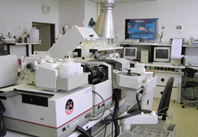
Research
|
Research |
With respect to its integration to the structure of the Faculty of Agriculture, the Department of Chemistry has been aimed at the environmental chemistry, chemistry of feeds, especially of silages. Fifteen years ago we started to work in the field of food chemistry. Selected naturally ocurring compounds with health impact are in the spotlight.
In food analysis we are aimed at matrices with high content of proteins. During decomposition these proteins are degraded to peptides and amino acids which consequently yield biogenic amines. These amines (e.g. putrescine and cadaverine) can serve as markers of food spoilage. These compouds are determined by capillary zone electrophoresis. In the last time we are working mainly on flesh of fresh water fish. Interesting results were obtained in beers, cheeses and sauerkraut.
Flavonoids rank among the group of plant polyphenolics with noticable antioxidant properties. Elevated consumption of these compounds in foods protects human cardiovascular system and may prevent some cancer diseases. Flavonoids are determined by capillary zone electrophoresis in important crops and pharmaceutically important plants.
Polyunsaturated fatty acids occur not only in sea fish but also in freshwater fish fat. These acids (e.g. docosahexaenoic, eicosapentaenoic) have beneficial effect on human cardiovascular system. They are determined by gas chromatography.